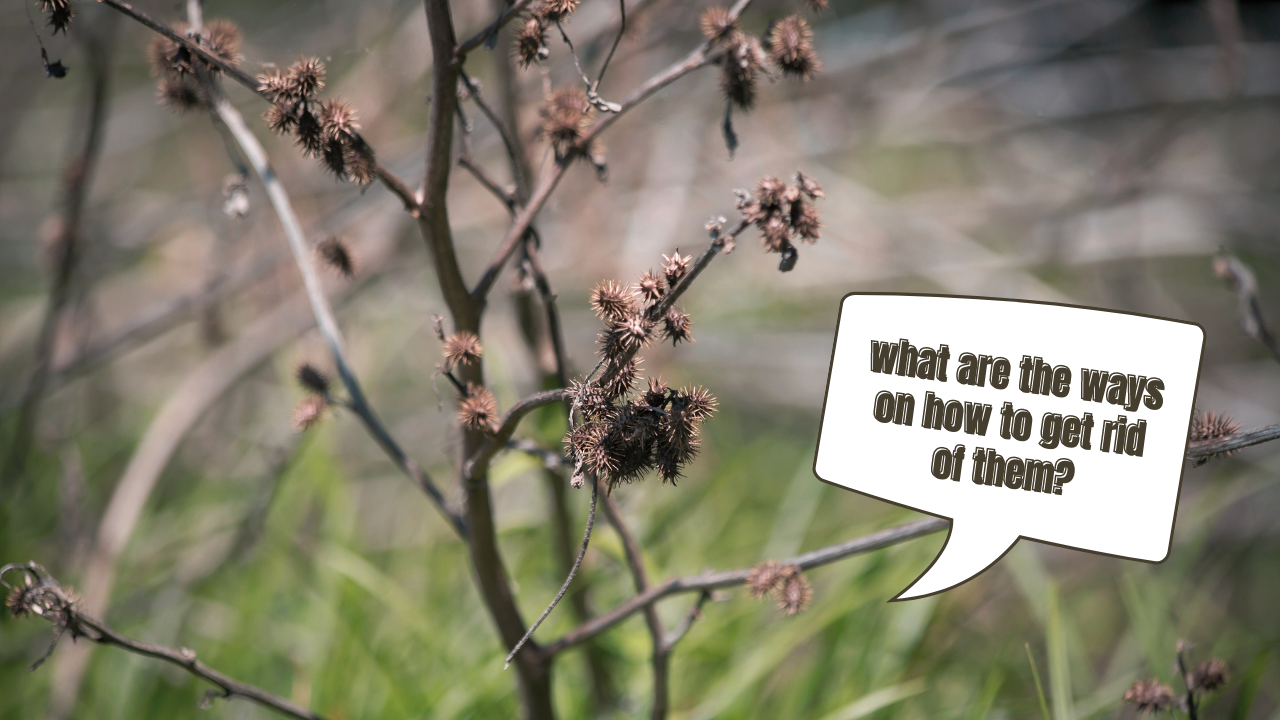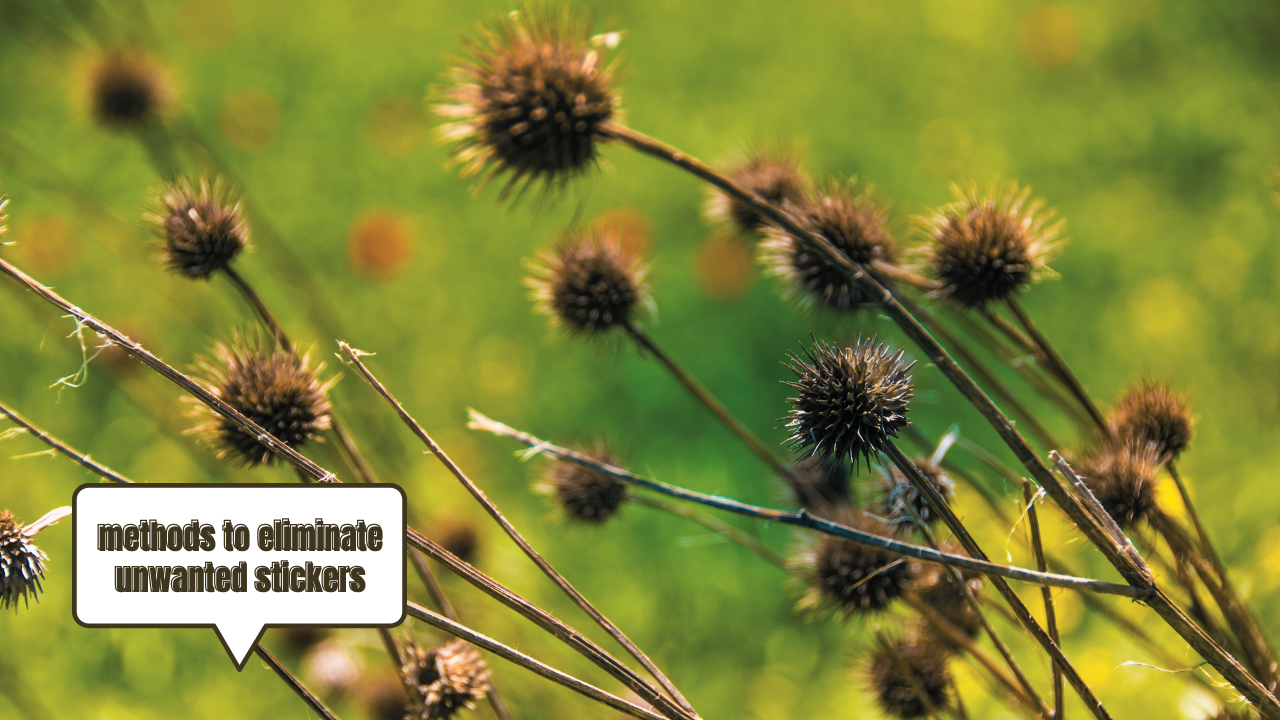If your beautiful, lush green yard is infested with notorious stickers– that can be such an eyesore. These sticker weeds will ultimately destroy the beautiful, tidy appearance of your lawn. Not to mention, they can also be bad for you and your family… So it’s best to act at once to get rid of stickers in your yard.
Getting Rid of Stickers in Your Yard

Below are the common methods on how to get rid of stickers in your yard and how to maintain a beautiful, tidy appearance of your lawn.
Assess the Scope of the Infestation
First, you will need to determine the severity of the sticker infestation on your lawn. The most common types of grass stickers are as follows:
Assess if the stickers are taking over the entire yard, or if it’s only showing up in little clusters. (Related: The Different Types Of Stickers In Your Grass And How To Deal With Them)
What to Do: Light Sticker Infestations
Homeowners dealing with a light sticker infestation will need to follow light maintenance activities to get rid of stickers in the yard. Fortunately, this won’t require expensive measures and some can be done using a DIY attempt.
The only downside? Creating these solutions will take time. Culture control will take multiple weeks to plan and schedule, but home remedies will require a bit more preparation time.
What to Do: Severe Sticker Infestations
When it comes to extensive sticker lawn infestations, you will need to remove all the weeds in your lawn (as well as some existing landscape) as you work on growing your yard once more. Commonly, there are two methods you can follow:
5 Methods to Get Rid of Stickers in Your Yard

Most homeowners find it rather challenging to fully eliminate the unwanted stickers in their yard. But, you can choose between herbicides or natural methods to eliminate these pesky weeds. Here are some of the best ways to get rid of burweed stickers for good:
1. Apply Pre-emergent Herbicides
To get rid of stickers in your yard ASAP, one of the best ways is to use pre-emergent herbicides to control the weeds even before they sprout. Note that this method can only be successful if carried out correctly.
Research when your particular sticker weed species start to sprout. Since burweed is known to sprout during cool weather, opt for lawn treatment before they can even emerge in the picture. You can do this at the end of the warm season months (late summer or early fall).
2. Manual Labor
Suppose it’s too late in the year for you to treat the lawn with a pre-emergent herbicide. In that case, you may need to invest some elbow grease in raking the burrs or pulling them away as you see them. Ensure to wear protective gloves to avoid hurting your hands from picking the stickers. Since it’s easy to unwittingly overlook some of the burweed, it would be best to do another method afterward.
3. Apply Post-emergent Herbicides
On the other side of the coin, post-emergent herbicides help kill existing weeds that are infesting your lawn. If you choose this sticker control method for your infested yard, ensure to only treat the affected area. Without caution, you may end up killing healthy turfgrass unwittingly.
4. Mow the Lawn Short Setting & Bag the Grass
Burr stickers are known to grow a bit close to the ground, so mowing in a close-cut setting will definitely help control their unwanted presence. Additionally, opt to bag the grass clippings to keep them contained. Following a short setting on your mower will help you get rid of these stickers on your lawn, but it's better to apply lawn treatment as well to kill off the roots that are left behind.
5. Use White Vinegar
If you do not like the idea of using toxic chemical herbicides, you can consider alternatives such as white vinegar. The acids in vinegar can help kill the sticker weed on your lawn, but it may also tend to harm the healthy grass surrounding the infected area. That said, ensure to apply your vinegar solution cautiously.
Pro Tip: Spray close to the weed (as much as possible) and avoid getting it on the unaffected areas. You may also dilute the vinegar mixture by adding more water to decrease its potency.
How to Prevent Stickers from Growing Back on Your Lawn
Clearing the unsightly stickers on your yard means you need to get rid of all the seeds lurking on it. The last thing you want is to see the seeds flying around, as you may need to do tiresome, time-consuming cleanups after every season.
Stickers can be a frustrating problem, but the sight of these pesky weeds doesn't mark the end of your lawn. Fortunately, there are different methods you can follow to get rid of stickers on your landscape.
When done right, you can bring back your lush, green turfgrass to its former glory and say goodbye to all the prickly, unsightly nonsense. (Related: How to Get Rid of Dollarweed in Your Florida Lawn: A Comprehensive Guide)
Frequently Asked Questions (FAQs)
What are yard stickers?
The plant itself is a grassy weed, but you are probably familiar with the sticker portion of the plant that comes off when it latches onto something. The seeds are spiny burrs, and they usually spread by sticking to a human or an animal. They often grow on Bermuda grass or St. Augustine grass and are abundant in dry places, particularly in hot weather climates.
How does a lawn get stickers?
An annual plant, burweed (burr plant, and several other names) leave stickers on the grass. Burr plants spread from lawn to lawn, just like any other weed, and burr stickers develop as a result. If you mow your lawn in the short set and forgot to carry a bag to collect the grass cuttings, lawn stickers may also emerge.
Does it hurt to touch sticker weeds?
Although the fruits of sticker weeds are small, when they come into touch with your skin, they may be quite painful. In addition, the placement of each spine makes it easy for them to stick to hair and clothing. It's difficult to pull them off after they've gotten a hold of one of these two mediums.
How quickly can sticker weeds spread?
Similar to how dandelion seeds quickly spread, sticker weeds do as well. A burr fruit moves to other outdoor areas where it is eventually released in a new spot after being stuck to your hair, clothes, or the coat of a wild or domesticated animal. Burr fruit pollinates similarly to a dandelion fluff, despite being bigger.
